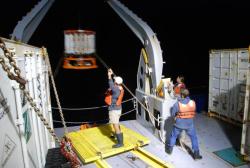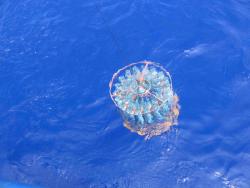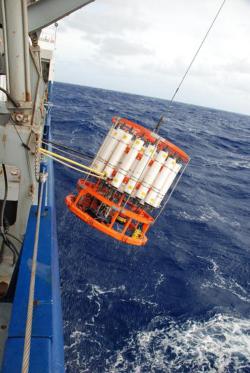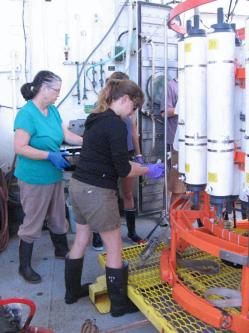Please note: You are viewing
the unstyled version of this website. Either your browser does not support CSS
(cascading style sheets) or it has been disabled. Skip
navigation.
Liz DouglassSampling on P6 started on Saturday Jan 9. The first cast went in the water at 3 AM, and came out of the water shortly thereafter, because the stream of data from the instrument to our computers was incomplete. A few hours later, a new "termination" was completed (the physical connection between the instrument and the cable), we re-deployed the CTD, and this time the data stream was perfect. From there, everything has gone pretty well. We have learned to get the CTD into the water, lower it to just above the bottom, stop, and bring it back to the surface. On the way back to the surface, we stop every so often (36 times, at prescribed depths depending on what the full depth of the ocean is) and "trip" the bottles, signaling them to close and preserve water with the properties from that depth. Once the CTD surfaces, we guide it back onto the ship, strap it down, and shift into sampling mode. Sampling is a complicated dance. Each group has a specific method (involving various temperatures, filters, additives, and rinsing techniques) and the "sample cop" makes sure no one goes out of turn. By now, we've gotten pretty good at deployment, recovery, and sampling. We'd had a few issues with swell in the past few days. Notably, on Wednesday or so, the rolling of the ship was causing big variations in the tension on the wire, which led to kinks in the wire. Since kinks notably diminish the strength of the wire, mechanical retermination was necessary; basically, after this process, the kinked part of the wire is no longer bearing weight (although it's still coiled up on top of the CTD, and the data still passes through it). I think three of four consecutive casts led to kinks on Wednesday. In addition to the swell, we've had full cloud cover for days -- no sunrises, no sunsets, no stars, just clouds. Thursday, however, was beautifully sunny and calm, and I was starting to think that maybe we'd have some nice weather. Turns out I was wrong. Some time Friday morning, the winds kicked up significantly, as did swell and wind waves. It was a funny little storm. Weather maps showed us just on the edge of it. We didn't even have full cloud cover, and the sun was shining through. But the sun was deceptive; we had sustained winds of 35 knots and higher gusts, enough to kick up some big waves and get the boat rocking and rolling. We still managed a reasonable deploy/recover of a cast, and sampling was exciting as we all tried to keep our balance on a wet deck, protected in the hangar from direct wind and waves but still dealing with water washing sloshing up from the waves at the edge. The storm passed quickly, the winds have steadied, the whitecaps are gone from the ocean, and last night we were treated to something I've been waiting for since we left port -- STARS. A whole sky full of them. The Southern Cross (as poetic to see as the song suggests), the brightest Milky Way you could imagine with mighty Orion hanging upside down from the end and the darkest black velvet background on which they're all hung. When you think about it, we're about as far from light pollution as you can get, and on a clear night, the view is really spectacular. Last updated: January 19, 2010 | ||||||||||||||||||||
Copyright ©2007 Woods Hole Oceanographic Institution, All Rights Reserved, Privacy Policy. | ||||||||||||||||||||




